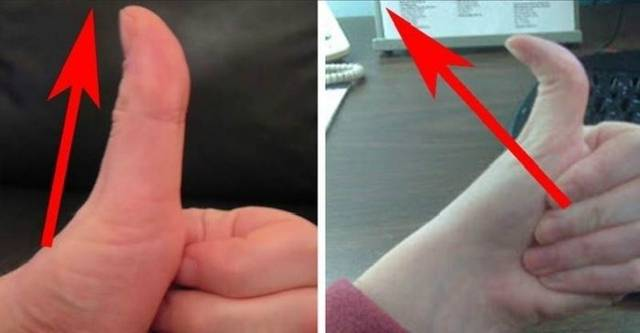
It’s a curious little party trick you might have seen—or tried yourself. Someone holds their hand flat, palm down, and then bends their thumb forward to touch their forearm. For some, it’s an easy feat. For others, the thumb barely moves, stopping at a resolute, upright angle.
If you’re in the latter group, you might have wondered what it means. Is it a sign of stiffness? A hidden superpower? The truth is, if your thumb doesn’t bend back significantly, your body isn’t trying to send you an urgent warning. Instead, it is quietly telling you a story about your genetic blueprint and the unique architecture of your joints.
This specific test is often referred to as the “hitchhiker’s thumb” test, and its result is primarily determined by the shape of the bone at the base of your thumb.
The Genetic Story in Your Joints
The joint where your thumb meets your wrist is called the carpometacarpal (CMC) joint. The end of the first bone in your thumb (the metacarpal) that forms this joint can have one of two general shapes:
- A shallow, flat surface allows for a greater range of motion, including that dramatic backward bend. This is what people often call being “double-jointed” (though the correct term is joint hypermobility).
- A deeper, more cup-like socket creates a stable, strong joint that is designed for power and grip, not for flexibility. This is the most common reason your thumb doesn’t bend back.
Think of it like door hinges. Some doors swing open a full 180 degrees, while others have a built-in stopper that only lets them open 90 degrees. Neither is broken; they were just designed for different purposes. Your thumb is the same. A stable, less flexible thumb is incredibly efficient for the tasks it evolved for—gripping tools, writing, and providing the powerful opposition that makes our hands so unique.
Beyond Genetics: When Stiffness is a Message
While genetics are the main character in this story, there are times when a change in your thumb’s flexibility can be your body trying to tell you something about your joint health.
If you notice a new stiffness, pain, or a grinding sensation (crepitus) when you try to move your thumb, especially if it’s accompanied by a loss of strength or a noticeable bump at the base, the message shifts. This could be a sign of:
- Osteoarthritis (OA): This is the most common cause of painful thumb stiffness, especially in people over 50. Often called “basal joint arthritis,” it occurs when the protective cartilage in the CMC joint wears down. The pain is typically felt at the very base of the thumb and is worse with pinching or gripping activities (like opening a jar or turning a key).
- Previous Injury: An old, perhaps forgotten, sprain or fracture can lead to long-term stiffness and limited range of motion.
- Tendon Issues: Inflammation of the tendons surrounding the thumb (de Quervain’s tenosynovitis) can cause pain and swelling that makes movement difficult.
What This Means For You
If your thumb has never bent backward and it doesn’t hurt, you can rest easy. Your body is simply telling you that you have sturdy, stable joints built for strength. There’s no need to try and force it.
However, if your thumb is becoming progressively stiffer, painful, or is making everyday tasks difficult, your body is asking for attention.
What to Do:
- For Painless, Genetic Stiffness: Celebrate your strong grip! No action needed.
- For New Pain or Stiffness:
- Listen to Your Body: Avoid activities that cause sharp pain.
- See Your Doctor or a Specialist: They can provide a proper diagnosis. For arthritis, they may recommend:
- Anti-inflammatory medication (like ibuprofen) to manage flare-ups.
- A supportive brace or splint to rest the joint.
- Occupational or Physical Therapy to learn exercises to strengthen supporting muscles and improve function without causing harm.
- In some cases, cortisone injections or even surgery for severe, debilitating arthritis.
So, the next time you see someone perform that thumb-bending trick, don’t worry if you can’t match it. Your body isn’t failing a test. It’s simply revealing its unique design—a design that has, for a lifetime, allowed you to hold the hand of a loved one, write a letter, and steady yourself through the world.